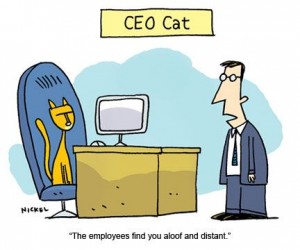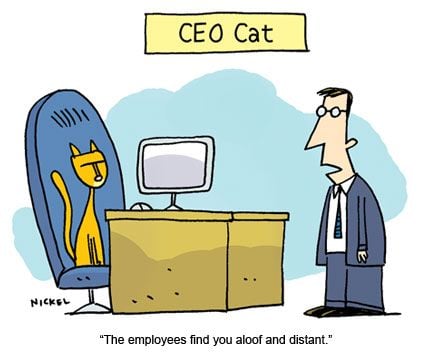 Effective communication strategies are the cure for CEOs and senior leaders who struggle to inspire and motivate their employees.
Effective communication strategies are the cure for CEOs and senior leaders who struggle to inspire and motivate their employees.
Yesterday was National Cat Day. One of many recent made-up holidays, it was a day for acknowledging the cat in your life (if you have one).
Being a cat-lover is truly a love/hate relationship for the following reasons:
- Cats are very independent and often don’t seek out your affection, but when they do, they’re lovely companions.
- Their personalities often seem unstable: their moods can turn on a dime – one second they love being petted, and the next second they try to bite you. It keeps life interesting.
- They tend to resist training of any kind and do whatever they please, but they are sturdy little creatures who avoid injury quite well.
(To preserve your sanity, it’s best to just accept cats the way they are and not try to change them.)
I may be reaching a little bit here, but the business world has too many CEOs who behave like cats. For example, check out the following cartoon:
This is a pretty accurate depiction of what it would be like if your CEO was a cat. Unfortunately, too many senior leaders behave the way cats do when they’re at their worst: inaccessible, moody, and resistant to any kind of help or feedback.
These behaviors do not promote a productive workplace. So here are three effective communication strategies to help CEOs and senior leadership be better managers.
Effective Communication Strategy #1
Problem: Being inaccessible
Solution: Proactively schedule some “face-time.”
Cats only give you their time when they feel like it, but CEOs and senior leaders can’t afford to act that way. Face-time with the boss is crucial to employees feeling heard, valued and recognized for their effort and accomplishments. It might seem hard to fit in face-time with your staff, but there are some fairly easy ways to work it into your routine:
- Take a brisk walk around the production floor or various departments to see how everyone’s day is going (and burn a few calories at the same time).
- Invite a different team/department to lunch with you once a month for some casual chit-chat. (Everyone has to eat anyway, right?)
- Hand-write a couple of “thank you” notes once or twice a month for a job well done.
Being more accessible to employees doesn’t have to eat up a lot of your time. Quick, small interactions are just as valuable and let your staff know you care, which will ultimately boost their engagement with their work.
Effective Communication Strategy #2:
Problem: Being distant and aloof
Solution: Channeling your inner “coach"
Employees and CEOs don’t have to be best friends, but these two groups must spend time together to optimize success. Coach your employees like you would if they were athletes. Behind every successful athlete is (usually) a good coach. Though some people are born with a lot of natural skill and aptitude for a particular sport, it’s their coach who nurtures and develops that talent.
And it’s the same at work: you can’t afford to be distant and aloof from your employees and let their potential go untapped. To perform their best, they need a coach. Look at the employee-boss relationship as a partnership that needs to be nurtured.
Effective Communication Strategy #3:
Problem: Being resistant to help or feedback
Solution: Concentrating on listening more
Unless they’re in the mood, cats resist basically everything you’d like them to do. CEOs and senior leaders who resist change or refuse to ask for feedback will create a lot of negative employee feelings.
One of the most important skills a manager can have is to listen, then listen, and then listen some more to their employees. If you’re only ever sending messages to your employees and never receiving their suggestions or including them in problem-solving, you’re missing the mark. And the less influence and autonomy employees have at work, the more likely they are to become disengaged or quit.
In a nutshell, to find out what would make your employees happier and more productive, just ask them! You might be surprised to find out that more money isn’t necessarily the answer.
Eliminating the love/hate relationship with your employees
If you’re a boss, you affect your employees’ feelings and decisions more than you might realize.
Did you know that an overwhelming majority (84%) of United States employees claim that their relationship with their boss is the number one determining factor for whether they try to move up in the company or find work elsewhere? (source: nbrii.com) That’s a lot of responsibility.
There’s no shame in recognizing that your behavior has been causing more problems than it solves. Once you’ve recognized the things you need to change, you can apply these effective communication strategies and take steps toward improving relationships with your employees, the lifeblood of your business.
Can you think of any other effective communication strategies to add to this list? Leave us a comment!







Leave a Comment